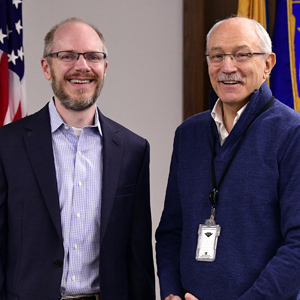
Last month, I visited the University of North Carolina Nutrition Research Institute (NRI) and learned how scientists there are using cutting-edge methods to advance precision nutrition. That research area, which falls under the umbrella of precision medicine, is about shedding light on what causes differences in metabolism and nutritional needs among individuals. The ultimate goal is to develop targeted nutritional interventions that improve health on a personalized level.
Precision nutrition research is complex because it must account for multiple factors that can affect our response to diet, such as genetics, epigenetics, metabolic processes, and environmental exposures. Susan Sumner, Ph.D., a professor of nutrition at NRI, works to untangle that complexity. She is an expert in metabolomics, which is the large-scale study of all metabolites in a biological specimen. Such analysis is a critical part of the precision nutrition toolbox.
Understanding how exposures disrupt metabolism and cause potentially harmful biological changes can increase understanding of what foods may help to reduce such effects. Metabolomics is an important framework for learning what an individual’s dietary needs may be in the context of multiple environmental influences ranging from lifestyle factors such as alcohol and tobacco use to the microbiome and air pollution.
Sumner hosted my visit to NRI, which is located in Kannapolis, North Carolina. I was joined by my colleague Geoffrey Ginsburg, M.D., Ph.D., who is the chief medical and scientific officer for the National Institutes of Health All of Us Research Program. That is a major research effort aimed at advancing precision medicine, which refers to individualized diagnosis, prevention, and treatment of disease. We learned how Sumner and her colleagues are helping to make the promise of precision medicine a reality through their research on nutrition and metabolism.
Afterward, I caught up with Sumner to learn more about her efforts at NRI, the importance of studying metabolism, how diet itself is a critical environmental exposure, how targeted nutritional interventions may help to reduce potential harm from exposures, and more. I also asked about what inspired her to pursue a biomedical career (see sidebar).
Understanding metabolism
Rick Woychik: Can you describe the work that you do at NRI?

Susan Sumner: NRI is located on the North Carolina Research Campus in Kannapolis, which was created about 12 years ago as a public-private partnership and includes eight North Carolina universities. Scientists here conduct studies on many aspects of nutrition, and our institute focuses on precision nutrition.
In my lab, I study metabolites, which are small molecules in our bodies that result from normal metabolic processes or environmental exposures including dietary intake, supplements, medications, and so forth. These collective exposures can disrupt metabolism in unique ways among different people, which is something I call metabolic individuality. That can lead to major differences in how a given person may respond to nutrition.
At NRI, we want to understand the optimal level of nutrients an individual needs, and that may depend on the person's genetics, metabolism of nutrients, and lifestyle factors such as tobacco, drugs, and alcohol. Such exposures can interfere with nutrient absorption, metabolism, microbiome composition and activity, and other important biological processes. So, when we look at that optimal level of nutrition, we would need to study all of these things together, using an exposome framework, and consider other factors such as exercise and life stage, because optimal nutritional levels change over time.
Essential nutrients
RW: You mentioned the exposome, which refers to the totality of our environmental exposures throughout life. Can you expand on the importance of studying diet itself as an exposure type?
SS: Diet may represent the most important exposure that people have in their daily life, and it is certainly one of the most important. For example, exposures that we get from foods and beverages provide nutrients to potentially protect against environmental insults, or they could introduce compounds that disrupt normal metabolic processes. Of course, we know that genetics is an important determinant of disease risk, but we also know that there is a link between diet and the onset, progression, and severity of various diseases.
Some environmental exposures cause inflammation, which can pave the way for disease. However, there are some nutrients, such as omega-3 fatty acids, that could combat inflammation. In addition, essential nutrients and dietary phytochemicals can serve as antioxidants because they scavenge free radicals that can damage cell membranes. Also, I mentioned earlier the importance of genetics. It turns out that when some vitamins are metabolized, they are involved in how genes are expressed. So, for example, we have nutrients that play a role in DNA methylation, which is a type of epigenetic change, meaning it alters gene expression but not by altering the underlying genetic code.
I want to emphasize that essential nutrients are called essential because they cannot be synthesized by the body or synthesized in the amount needed by the body. These nutrients are necessary for normal growth, development, and reproduction. They provide energy, and they serve as cofactors in hundreds of important biochemical reactions involved in normal metabolism. So, if you don't have essential nutrients at your optimal level at the right time and right place, your metabolism may not function properly.
Dietary interventions
RW: Can you provide Environmental Factor readers with a couple of examples of metabolic disruptions you have studied and potential nutritional interventions you have identified?
SS: In one study, we looked at stool biospecimens of obese individuals who were diagnosed with osteoarthritis and some individuals diagnosed as not having osteoarthritis. In the first group, we found significant metabolic disruptions related to excretion of products of proteolysis, which refers to the breakdown of proteins. That indicated the potential for intestinal permeability, and that can be harmful because if you break down the intestinal barrier, your absorption of nutrients can be adversely affected. Also, this intestinal breakdown promotes increased inflammation due to leakage of intestinal microbial products into the blood.
We were able to propose a nutritional intervention controlling for the ratio of omega-3s to omega-6s, meaning we wanted to see higher omega-3s to mitigate inflammation. We also proposed a higher level of fiber in the diet because that is related to the production of short-chain fatty acids. We saw that these short-chain fatty acids and the microbes that produce them decreased in the osteoarthritic group. We also saw an association between environmentally relevant chemicals and perturbations in endogenous metabolism, which may play a role in onset or progression of disease. I should note that I'm not the person who gives recommendations because these really need to be made in consultation with registered dietitians. They're going to be the individuals who can connect with a given community and really understand what their needs are and what their food access situation looks like, which can inform recommendations and help to reduce disparities.
Another study involved analysis of people with opium use disorder. We saw disruption across numerous metabolic pathways, and based on that information, we proposed what I call a nutrient cocktail. It would include certain vitamins, vitamin-like compounds, and other nutrients that may help to stop the development of addiction, progression of addiction, and relapse. Our conclusions are broadly applicable to other drugs and to some extent tobacco use, and we’re excited about expanding on this work in the future.
Advancing precision nutrition
RW: I understand that you are participating in the National Institutes of Health Common Fund’s Nutrition for Precision Health [NPH] initiative, which will help to expand on the All of Us Research Program. Can you describe what research you will conduct?
SS: My team will conduct in-depth analyses using metabolomics tools that we developed thanks to NIEHS support for our Human Health Exposure Analysis Resource hub. Participants in our NPH cohort will provide information regarding their habitual diet, and we’ll also receive data regarding physical measures and behavioral phenotypes.
In addition, some individuals will receive special diets, which will allow for even greater insight into how individuals respond to their nutrition in combination with factors such as tobacco, drugs, medication, and other environmental exposures. We’ll analyze the metabolic effects of study participants’ diets and see how the effects vary across their diets and exposures.
A key aspect of NPH is that there are participating clinical sites across the country, and we plan to include a diverse population. That will enable us to dive deep into precision nutrition, and I think it will lead to important discoveries. I am excited that our team at UNC Chapel Hill and the NRI will contribute to this project, and I look forward to seeing the science progress.
Citations:
Rushing BR, McRitchie S, Arbeeva L, Nelson AE, Azcarate-Peril MA, Li YY, Qian Y, Pathmasiri W, Sumner SCJ, Loeser RF. 2022. Fecal metabolomics reveals products of dysregulated proteolysis and altered microbial metabolism in obesity-related osteoarthritis. Osteoarthritis Cartilage 30(1):81–91.
Li YY, Ghanbari R, Pathmasiri W, McRitchie S, Poustchi H, Shayanrad A, Roshandel G, Etemadi A, Pollock JD, Malekzadeh R, Sumner SCJ. 2020. Untargeted metabolomics: biochemical perturbations in Golestan Cohort Study opium ssers inform intervention strategies. Front Nutr 7:584585.
(Rick Woychik, Ph.D., directs NIEHS and the National Toxicology Program.)









